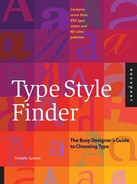
A Type and Color Primer
The Origins of Type: An Abridged History
Our modern conception of type comes to us after a 4,000-year
trek through Mesopotamia, Egypt, Greece, and the Italian
peninsula, and finally into western Europe. The Roman alphabet,
codified during the second and first centuries
B.C. and initially
inscribed with a chisel, derives from Greek lapidary (stone-carved)
writing, evolved over millennia from characters developed by
the Sumerians, Etruscans, and Phoenicians. Besides introducing
additional characters, the Romans simplified the structure of
existing characters; retaining a single thickness in the character
strokes. Eventually, scribes began to plan inscriptions by painting
on the stones before carving. The square-cut reed pens and
brushes they used left contrasting marks, and the resulting thick
and thin strokes (shading), along with serifs, would profoundly
influence letterform construction for the next 2,000 years.
The quadrant-proportioned, so-called “square capitals” of the
first century A.D. mark the beginning of modern writing, no
longer reserved for Imperial documents alone. Further simplified
shapes called majuscules and minuscules, popularized after
Rome’s fall in 476 A.D., would later become the modern lower-
case, during the Medieval period (500–1300 A.D.). Charlemagne,
the Frankish conqueror who united much of feudal Europe
during the eighth century, is often credited with standardizing
the writing of minuscules and majuscules across his empire.
With the eventual disintegration of Charlemagne’s empire in
the 900s, however, a shift toward more regional scripts of varying
roundness and contrast—the Gothic Textura and Fraktur—held
sway until the fourteenth century, when Renaissance humanists
rediscovered Carolingian scripts and took them as their model
for developing new alphabets.
Coincidentally, the thirteenth and fourteenth centuries also
marked the introduction of wood-block printing and papermak-
ing to Europe from the East. Eventually, a quest for quicker
production methods was undertaken. Most historical evidence
credits a German inventor, Johannes Gutenberg, with adapting
several technologies to create a system of reusable, durable,
and extraordinarily precise letters in metal and transferring
their image onto paper at a remarkable speed. His first project,
a Bible set with moveable type, was printed in 1455.
4
Roman cursive capitals Fourth century A.D.
Written Roman capitals Second century A.D.
Roman lapidary capitals First century A.D.
Greek lapidary capitals Carved in stone, 500 B.C.
Sumerian cuneiform Impressed in clay: 1600 B.C.
Section I
(Provision) Type Style Finder
CD606.006 / 4108
1 TSF_FM_001-015_new.qxd 6/3/06 10:24 AM Page 4

Type Style Finder
5
Printed textura type 1450
–
1500 A.D.
Gothic textura writing 1250
–
1300 A.D.
Carolingian majuscule and miniscule 750
–
800 A.D.
Carolingian half-uncials 700
–
800 A.D.
Roman cursive miniscule Fifth century A.D.
The subsequent evolution of printing technology encouraged
dramatic exploration of design ideas, and printers refined new
approaches to the alphabet over the course of the next few
centuries. Within a period of 500 years, the design of letters
underwent a radical shift in form, progressing beyond the
Carolingian-inspired, brushlike organic strokes of oldstyle
toward more rational drawings that were increasingly precise,
sharper in detail, bolder, simpler, and increasingly more uniform
in proportion. By the early twentieth century, a new form—
the sans serif—had become common, symbolic of corporate
identities and the emerging International Style of typographic
design. The stylistic neutrality of these sans-serif forms spoke
to the idea of a universal visual language. In 1952, the Swiss
type foundry Haas released Helvetica, a sans-serif family with
an extraordinarily large lowercase and an optical uniformity
among the letters that is rivaled only by Univers, released
by Monotype in 1958. Strikingly, these modern forms retain
evidence of their origin in the brush some 2,000 years ago.
Now well into the early phase of a technological revolution,
designers have become comfortable manipulating existing
forms, as well as constructing new ones when needed—a
process made possible by the personal computer and resulting
in intuitively designed faces that challenge notions of proper
construction and legibility. As font designer Zuzanna Licko of
Émigré, one of the pioneering digital type houses of the early
1990s, has said, the legibility of typefaces changes over time
through use. Complicated textura forms, for example, were
considered quite legible in the fifteenth century but today are
seen as hard to read.
Whatever the form, typefaces carry messages above and beyond
the words that they spell out—emotional responses or associa-
tions that viewers make in response to a typeface’s formal
details. To a large degree, this response is subjective and based
on the viewer’s personal experience and cultural background.
Some designers say that this variable makes the choice of
typeface irrelevant—that it is what the designer does with the
typeface’s size and arrangement in a composition that imparts
communication. But in the sense that designers often speak to
very targeted audiences, the choice of typeface as part of the
communication can be an effective part of resonating with a
particular group. So long as the designer can understand appre-
ciate the formal, visual characteristics of a typeface’s strokes
and details that contribute to such associations, he or she can
make intelligent decisions about finding the right type style for
the job at hand.
(Provision) Type Style Finder
CD606.006 / 4108
1 TSF_FM_001-015_new.qxd 6/3/06 10:25 AM Page 5
..................Content has been hidden....................
You can't read the all page of ebook, please click here login for view all page.
